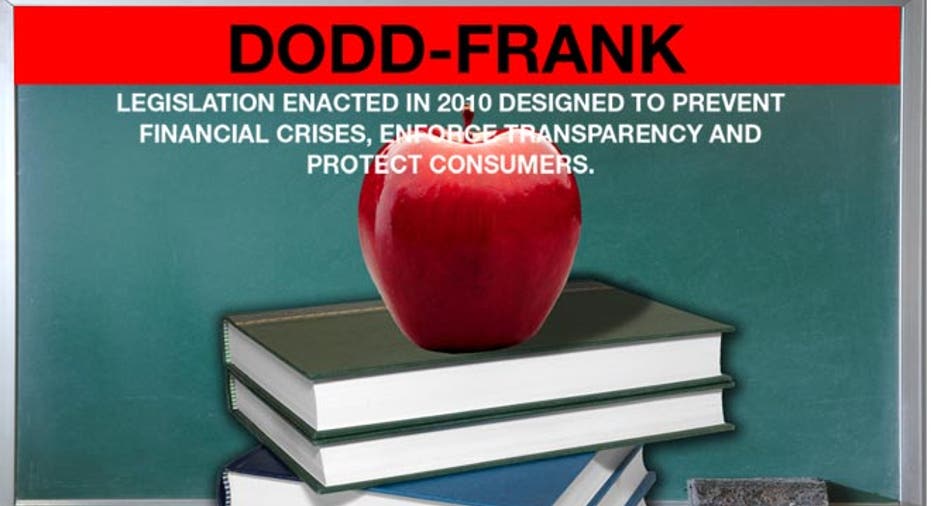Dodd-Frank Just Entered Kindergarten

Dodd-Frank just turned five-years old today, but can the confetti and the hats and horns.
For one, the government still effectively subsidizes mortgages, a practice that led to the financial collapse, and “too big to fail” banks that the Administration vowed to abolish with Dodd-Frank got even bigger.
It was the most sweeping bank reform since the Great Depression, one that introduced the Consumer Financial Protection Bureau, which has turned back billions of dollars to consumers in the form of mortgage and consumer credit reimbursements for alleged fraud, among other things.
Dodd-Frank cracked down on derivatives trading, and pushed banks to build bigger capital buffers to reduce the risk of “systemically important” financial institutions from collapsing, like Lehman Brothers. It also launched the Volcker Rule, which stops banks from engaging in risky proprietary trading for their own profit.
The legislation also unleashed a barrage of new rules to transform the banking system, including new leverage ratios, liquidity ratios, stable funding ratios, and ratios on risk-weighted assets.
Many of the new rules never saw the light of day in a Congressional hearing, since the Federal Reserve, which helped pencil these new requirements, is exempt from cost-benefit requirements, whereby other regulators must assess the costs or economic impact of their regulations.
Meanwhile, consumers and businesses are not exempt from higher banking and loan fees that bankers complain they had to enact to deal with the impact of the new rules.
Moreover, the law firm Davis Polk figures that just two-thirds of the Dodd-Frank rules have been finalized, and more than 20% of the laws’ required rules have yet to be proposed. Already, Wall Street has created an army of new workers just to deal with the law, leading one banker to quip: “See, the government really does create jobs.”
But as banks are laying off workers in operating positions, those jobs are being replaced by workers who must answer more than half a dozen government agencies’ every request, including the Federal Deposit Insurance Corp., the Treasury Dept., the Securities and Exchange Commission, the Office of the Comptroller of the Currency, as well as the Federal Reserve.
However, the law didn’t stop “too big to fail.” Today, the top 25 banks in the U.S. command over 56% of the total assets, according to estimates by the Federal Reserve. That’s an increase from June 2007, when the top 25 banks controlled a little over 53% of the total assets in the system. To combat too big to fail, the Federal Reserve just enacted a “surcharge” that applies to eight of the biggest U.S. banks, set to take full effect in 2019, meaning they must hold more capital than their smaller peers.
The financial reform law has also been blamed for hamstringing the estimated $10 trillion market for U.S. corporate debt, with fears that the law could exacerbate an interest rate shock for big companies.
The Volcker Rule is being blamed as the reason why large banks have dialed back their trading in some of the riskier parts of the corporate bond market, because the new regulation made it more costly and difficult to keep those bonds on their balance sheets. The restrictions dealing with risk discourages the intermediation role of the financial sector in these bonds. The belief is, the less able they are to take on big inventory positions in these debt securities, the less they can act as a buffer when investors are running for the exits.
Meanwhile, the Volcker Rule exempts Treasury holdings and Fannie Mae and Freddie Mac debt from its restrictions. Meaning, banks can continue to conduct proprietary trading in these securities. As of last fall, bank holdings of Treasuries had increased eightfold since 2007, based on FDIC data. In turn, primary dealers’ inventories of corporate-debt securities sunk to $38 billion, versus a high of $285 billion in 2007, according to the Federal Reserve Bank of New York.
Dodd-Frank is also of a piece with the notion that the same regulators who missed the 2008 crisis, who turned a blind eye to Citigroup’s (NYSE:C) off balance sheet vehicles sitting in plain sight, will somehow catch or stop the next crisis, thanks to the new law. This, even though bank regulators still missed JPMorgan Chase’s (NYSE:JPM) “London Whale” trading loss in 2012, despite the Wall Street Journal reporting that Morgan's "whale" trades were the talk of London and Wall Street. There also is still no talk in Dodd-Frank of the government’s subsidization of mortgage risk, after Fannie Mae and Freddie Mac got an estimated $188 billion bailout.'
Dodd-Frank has also been blamed for hurting community banks, which are important to small businesses and economic growth, the drivers of job creation. These smaller banks are typically the only financial institutions in an estimated 1,200 U.S. counties. Even though they had nothing to do with the financial crisis, they got caught up in the rush to regulate, in the “one size fits all” answer the government came up with.



















